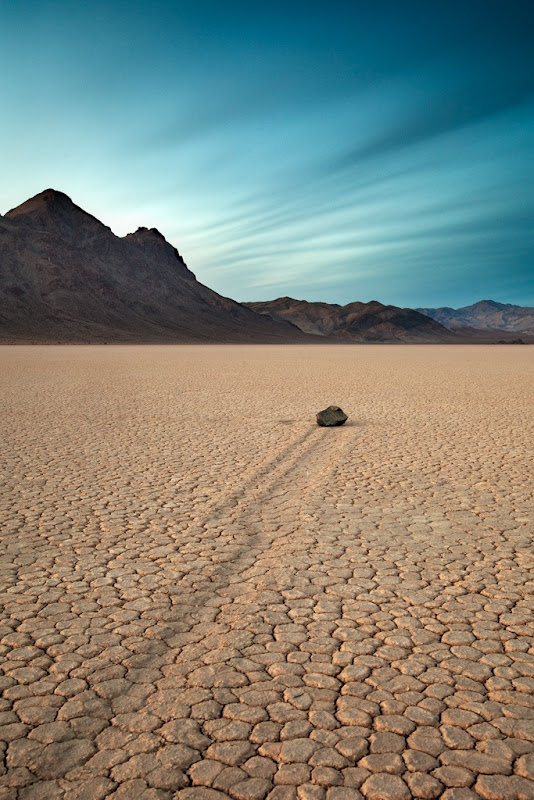The Racetrack Playa is an exceptionally flat and dry lakebed located above the northwestern side of Death Valley, in Death Valley National Park, California. The playa is best known for one of the most strangest mysteries of the planet – the sliding rocks. These rocks can be found on the floor of the playa with long trails behind them. Although no one has actually seen the rocks move, the long meandering tracks left behind in the mud surface of the playa attest to their activity. Some of these rocks weigh several hundred pounds and have traveled as far as 1,500 feet, which leaves us with the question: "How do they move?"
The stones move only every two or three years and most tracks develop over three or four years. Stones with rough bottoms leave straight striated tracks while those with smooth bottoms wander. Stones sometimes turn over, exposing another edge to the ground and leaving a different track in the stone's wake.
Trails differ in both direction and length. Rocks that start next to each other may travel parallel for a time, before one abruptly changes direction to the left, right, or even back the direction it came from. Trail length also varies – two similarly sized and shaped rocks may travel uniformly, then one could move ahead or stop in its track.

One early suggestion was that the rocks were driven by gravity, sliding down a gradual slope over a long period of time. But this theory was discounted when it was revealed that the northern end of the playa is actually several centimeters higher than the southern end and that most of the rocks were in fact traveling uphill.
Though no one has yet been able to conclusively identify just what makes the rocks move, one woman is coming closer to solving the mystery. For the past ten years, Dr. Paula Messina, professor of geology at San Jose State University in California, has been tracking the movement of each of the 162 rocks scattered over the playa. Her research suggest that a rare combination of rain and wind conditions enable the rocks to move. A rain of about 1/2 inch, will wet the surface of the playa, providing a firm but extremely slippery surface. Strong winds of 50 mph or more, may skid the large boulders along the slick mud. At an elevation of 3,700 feet, strong winds can rake the playa at 70 miles per hour. But even small gust of wind may move the rocks.
Some people have suggested attaching radio transmitters to the rocks or erecting cameras to catch them “in the act” in order to put an end to the speculation. But as Death Valley National Park is 95 percent designated wilderness, all research in the park must be noninvasive. It is forbidden to erect any permanent structures or instrumentation. Further, no one is permitted on the playa when it is wet because each footprint would leave an indelible scar.







कोई टिप्पणी नहीं:
एक टिप्पणी भेजें